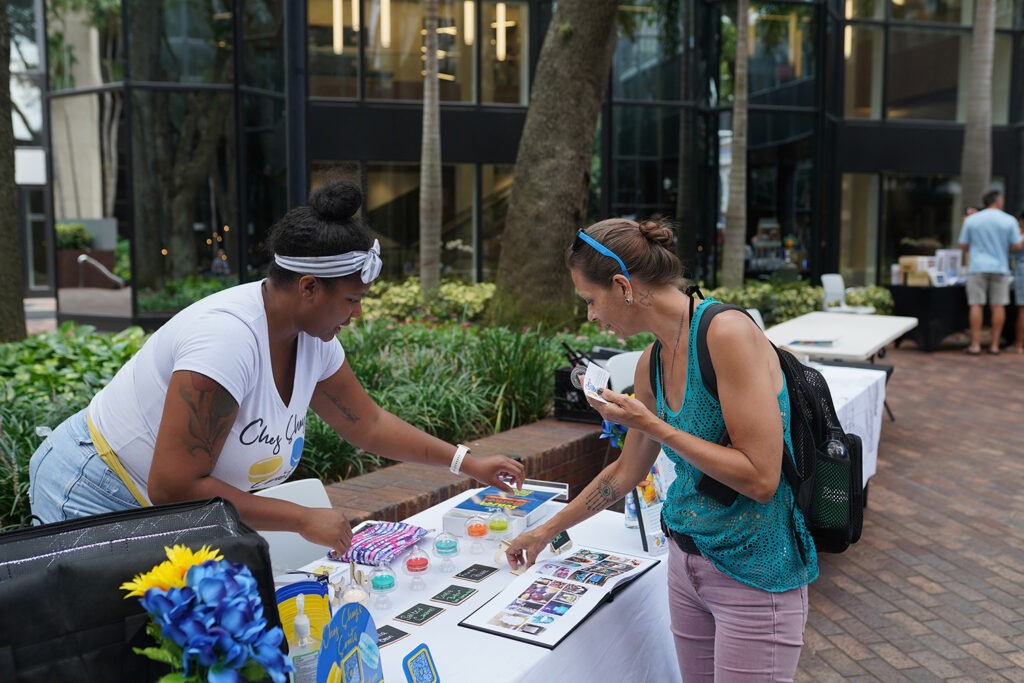The annual convention drove home stewardship as key to prosperity for locals, visitors and meetings alike
At Destinations International (DI) Annual Convention, 2024 (DIAC24), in Tampa, Fla. this past July 16-18, DI CEO Don Welsh’s opening remarks brought forward a wave of laugher from the crowd after he shared that the awe-inspiring drone show that kicked off the 2024 Annual Convention used an astounding 300 drones—and 298 of them made it through to the end! Ah, the drone show: the latest meetings industry favorite. Each one we see seems to get even better than the last.

The night prior had seen attendees gather in Sparkman Wharf for a night brimming with excitement amongst local bites and drinks, alongside that spectacular drone show.
In the opening ceremony, the crowd of 1,850 attendees—coming from 30 international delegations—were greeted by Santiago C. Corrada, President and CEO of Visit Tampa Bay, and Jane Castor, Mayor of Tampa. Together, the two expressed their passionate dedication to Tampa, sharing excitement for the destination’s continued growth and core values of being a safe, welcoming destination.
In an era that seems defined by divisive politics, Welsh addressed the continued debate around boycotting destinations when the organization holding and attending the meeting disagrees with politics in that area. “Destinations International is not in support of boycotting destinations,” Welsh said. “When a destination struggles, we go there to help and learn. ”
Read More: Buycott, Don’t Boycott
The Tampa Case Study Initiative

In April, DI announced a comprehensive community engagement initiative for its annual convention in Tampa, that would demonstrate how organizations like DI can hold a meeting or convention that goes above and beyond to create positive impact in the destinations where they take place.
The press release opens stating that when DI announced Tampa as the annual convention’s destination, “the choice sparked debate among members due to recent Florida laws targeting women, the LGBTQ+ community and African Americans.” Welsh stated, in the release, “Choosing Tampa was a purposeful act to promote engagement and understanding…we recognize the concerns raised by our members and see this as an opportunity to highlight the importance of showing up, immersing and positively impacting the communities we visit.”
The Tampa Case Study Initiative was structured around four central components: community engagement, community support, lasting impact and local investment. Although the information demonstrating the impact post-convention is still being collected, the feel of moving through DIAC24 and seeing firsthand the activations, education sessions, award ceremonies and local community engagement set the stage to easily anticipate the initiative’s robust success.
Read More: Destinations International Helms Meetings Industry Diversity Study
The Impact So Far (…and counting!)
When Smart Meetings sat down with Welsh on the final day of the convention, he shared, “I think when [destinations] see this case study, they will know that we made conscious decisions, like the opening and closing celebrations to be in Ybor City, and to make sure that we’re going into facilities that match up with our commitment to social inclusion.”
That Tuesday afternoon of the conference, DI held a volunteer activity with Feeding Tampa Bay, a local nonprofit that works to tackle food insecurity. 50 DIAC attendees—the maximum number of volunteers the space was able to accommodate—participated. The next day, Visit Tampa Bay held a “Sunset Market: Sip, Savor and Shop,” where local businesses and F&B partners, many of which are minority-owned, could showcase and sell their goods to attendees.

When it comes to planners seeking to make the same impact, Welsh advises, “Make sure there is a conscious effort, when looking at restaurants or looking for talent; go deeper than the normal suspects. This forces you to consider, ‘Okay, what vendors am I going to use, how am I really going to give entrepreneurs and small business the opportunity to benefit?’”
Read More: Bright Lights, Big City Resorts
Some of Tampa’s spectacular local talent showed up in a full-scale Cuban salsa dancing production prior to the opening keynote as attendees filed into the ballroom. The level of showmanship was one thing; the production’s ability to immerse the ballroom of attendees into a central aspect of Tampa’s local culture brought it to the next level.
Not only did DI work to engage local businesses; members of the Tampa community took part as well. Three local, high-potential high school students with interest in destination careers, identified by NAACP Hillsborough County, spent the convention shadowing DI staff.
In order to leave a long-term impact, post-meeting and beyond, DI established a Giving Circle. Donations given by attendees throughout the conference were directed to Feeding Tampa Bay, as well as two more local nonprofits: Dress for Success Tampa Bay and Rebuilding Together Tampa Bay.
The Impact Across Destinations, Internationally

An opening keynote from Arthur Brooks, happiness expert and Harvard Business School professor, drove home the point that the rest of the convention would center around: happiness is the key to success; not the other way around.
When a community is happier, it becomes a more successful destination. The breakout sessions that followed throughout the conference would include stewardship success stories and education sessions to equip attendees with the knowledge, connections and tools they would need to create the same type of happiness in each of their own respective destinations.
What does Destinations International hope attendees return home with having gained? Welsh explains, “I hope that those of us who heard Arthur speak, and overall have been in this positive environment, take these lessons back to their fellow team members. It all goes back to: people’s mental and emotional health are desperately needed. And we take that very seriously.”
Lessons for Planners
When it comes to planners and destinations working together to put on great events like this one, Welsh says, “I think that, right now, planners have a better understanding of what a destination needs from them. Use Tampa as an example. Somebody may be offended by the legislation that’s going on in the state of Florida; but there is record attendance here, of minority groups, of minority leisure travelers. Planners understand that we are in a very different cycle, and there is great communication right now in terms of the planner community and destinations.”
Partnering with Destinations to Create Stewardship
 When planners look at destinations to book a meeting, they can act as an advocate to get tourism dollars into local businesses. In a panel during DIAC24, “Making the Catalytic Case for Your Destination Organization,” the audience heard from representatives from Visit Seattle, Great Lakes Bay Regional Convention & Visitors Bureau and Destination Greater Victoria. All were part of a larger study of 29 destinations which had been assessed by Tourism Economics for the broader economic benefits of destination marketing across the quality of life, local culture development, employment growth and more in the destinations selected for the study.
When planners look at destinations to book a meeting, they can act as an advocate to get tourism dollars into local businesses. In a panel during DIAC24, “Making the Catalytic Case for Your Destination Organization,” the audience heard from representatives from Visit Seattle, Great Lakes Bay Regional Convention & Visitors Bureau and Destination Greater Victoria. All were part of a larger study of 29 destinations which had been assessed by Tourism Economics for the broader economic benefits of destination marketing across the quality of life, local culture development, employment growth and more in the destinations selected for the study.
President & CEO of Tourism Economics Adam Sacks, who moderated the conversation, shared, “One of the things we found in the study is that as a destination increases their visitor-related employment, it actually has a net catalytic effect on other areas of employment. By the fourth year, if you’re able to increase visitor-related employment [by 10%], that has a causal generation of an additional 2% employment in other sectors [relative to the U.S. average].”
Transforming Business Travel
Welsh says that the MICE industry is crucial to the success of a destination’s tourism economy—and based on the impact tourism has on the wider economy, the MICE industry is crucial to the success of a destination. “If you look at how you fill cities, it’s the same way you fill a hotel,” says Welsh. “The business traveler is back, which is important. Because, mid-week, Tuesday through Thursday, or Monday through Wednesday, is when hotels will have a slightly lower occupancy. But when you have business travel and meetings, all of a sudden, that hotel does not have these swings of occupancy.”

The way people travel has changed, as well. “Rather than come to the city, check into the hotel, go to the meeting and then leave—those days are over—people may stick an extra day on the front or back end,” says Welsh. “They want to go to the same restaurants that locals are in, do the same things that locals do…What’s happening in destinations is that they have to make it worthwhile for visitors to leave their homes and go to that place.”
Business travelers bring essential business to a destination, certainly in the hospitality industry, and, with the rise of “bleisure” travel, the broader local economy.
Read More: Lessons from Leaders with Don Welsh
A Better Destination, at Home and Away
Destinations International Annual Convention in Tampa this year certainly set the standard. Santiago C. Corrada, Visit Tampa Bay’s president and CEO, stated in DI’s April press release, “Tampa’s vibrant spirit and dedication to welcoming all communities reflect our mission to make a positive and lasting impact. Our foundation as a multicultural community and our leadership in inclusivity are well-known and respected. We stand united in celebrating and promoting these ideals at every opportunity.”
With opportunities to explore Tampa far and wide within the context of robust education around the role of destination professionals, stewardship and overall creating happier communities to welcome happier visitors, attendees left DIAC24 equipped to not only serve the planners they’ll see coming in, but also strengthen and celebrate their local communities.




